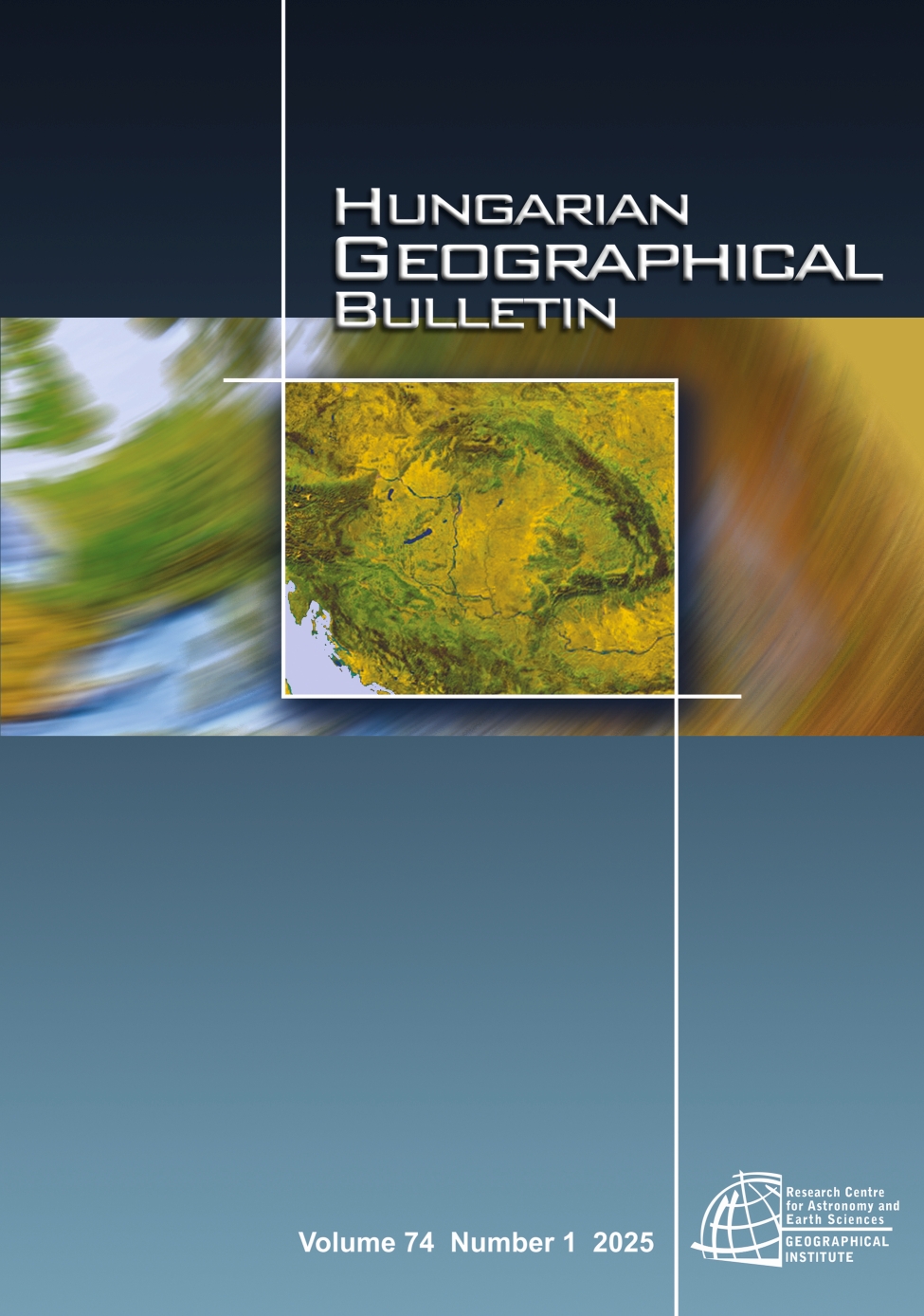Human and demographic capital in peripheral and core municipalities and regions and its development (northwest Bohemia)
Absztrakt
The paper compares the human and demographic capital of central, suburban, semi-peripheral and peripheral municipalities of the Karlovy Vary Region and also the regions of Czechia and neighbouring regions in Germany. Peripheral municipalities are considerably distant from meso- and micro-regional towns in terms of time spent on public transport. The demographic capital of municipalities is assessed according to indicators of population development, natural and migration balance, and age structure. In the evaluation of human capital, indicators of education, unemployment, foreclosures, entrepreneurship, and housing construction are used. The assumption of low human capital in peripheral municipalities compared to more geographically exposed municipalities was not confirmed. Suburban municipalities have the highest human and demographic capital. Although the studied region borders the developed regions of Germany, it has the least favourable values of human and demographic capital of all Czech regions and neighbouring German regions. This is a consequence of the complete population exchanges after World War II, the existence of the Iron Curtain on the region’s borders with the West during the socialist (communist) period, the peripheral location of the region within Czechia, the inappropriate development of industry under socialism, and the problems of this sector and weak cross-border cooperation in the post-socialist period. The paper also presents strategies and measures to support human capital in the types of municipalities of the region and throughout the region.
Hivatkozások
ADSERA, A. 2004. Changing fertility rates in developed countries. The impact of labor market institutions. Journal of Population Economics 17. 17–43. https://doi.org/10.1007/s00148-003-0166-x
AGARWAL, S., RAHMAN, S. and ERRINGTON, A. 2009. Measuring the determinants of relative economic performance of rural areas. Journal of Rural Studies 25. (3): 309–321. https://doi.org/10.1016/j.jrurstud.2009.02.003
BECKER, G. 1964. Human Capital: A Theoretical and Empirical Analysis with Special Reference to Education. Chicago, The University of Chicago Press.
BERNARD, J. and ŠIMON, M. 2017. Vnitřní periferie v Česku: Multidimenzionalita sociálního vyloučení ve venkovských oblastech (Inner peripheries in Czechia: The multidimensional nature of social exclusion in rural areas). Sociologický časopis / Czech Sociological Review 53. (1): 3–28. https://doi.org/10.13060/00380288.2017.53.1.299
BLAŽEK, J. and CSANK, P. 2005. The West-East gradient and regional development: The case of the Czech Republic. AUC Geographica 40. (1–2): 89–108.
BLUNDELL, R., DEARDEN, L., MEGHIR, C. and SIANESI, B. 1999. Human capital investment: The returns from education and training to the individual, the firm and the economy. Fiscal Studies 20. (1): 1–23. https://doi.org/10.1111/j.1475-5890.1999.tb00001.x
BOLELOUCKA, E. and WRIGHT, A. 2020. Spa destinations in the Czech Republic: An empirical evaluation. International Journal of Spa and Wellness 3. (2–3): 117–144. https://doi.org/10.1080/24721735.2021.1880741
BONTIS, N. and SERENKO, A. 2007. The moderating role of human capital management practices on employee capabilities. Journal of Knowledge Management 11. (3): 31–51. https://doi.org/10.1108/13673270710752090
BRIXY, U., BRUNOW, S. and OCHSEN, C. 2022. On the peripheral-urban wage gap in Germany. Applied Geography 139. 102647. https://doi.org/10.1016/j.apgeog.2022.102647
CHYTIL, M.K. 1982. A centralized biomedical research data-processing unit and the stages of its development. Medical Informatics 7. (1): 39–48. https://doi.org/10.3109/14639238209020641
COLEMAN, J.S. 1988. Social capital in the creation of human capital. American Journal of Sociology 94. 95–120. https://doi.org/10.1086/228943
DOWNES, R. 1996. Economic transformation in Central and Eastern Europe: The role of regional development. European Planning Studies 4. (2): 217–224. https://doi.org/10.1080/09654319608720341
ELHORST, J.P. 1998. The non-utilization of human capital in regional labor markets across Europe. Environment and Planning A, 30. (5): 901–920. https://doi.org/10.1068/a300901
FRANTÁL, B., PASQUALETTI, M.J. and BRISUDOVÁ, L. 2024. Challenges, dilemmas and success criteria of recycling coal mining landscapes. Moravian Geographical Reports 32. (4): 216–232. https://doi.org/10.2478/mgr-2024-0018
GÁL, Z. and PÁGER, B. 2017. The changing role of universities and the innovation performance of regions in Central and Eastern Europe. In Routledge Handbook to Regional Development in Central and Eastern Europe. Ed.: LUX, G., London, Routledge, 225–239. https://doi.org/10.4324/9781315586137-14
HAMPL, M. 2003. Diferenciace a zvraty regionálního vývoje Karlovarska: Unikátní případ nebo obecný vzor? (Differentiation and turns in regional development of Karlovy Vary region: A unique case or a general regional pattern?). Geografie – Sborník CGS 108. (3): 173–190. https://doi.org/10.37040/geografie2003108030173
HAMPL, M. and MARADA, M. 2015. Sociogeografická regionalizace Česka (Sociogeographical regionalization of Czechia). Geografie 120. (3): 397–421. https://doi.org/10.37040/geografie2015120030397
HAMPLOVÁ, E., BAL-DOMAŃSKA, B. and PROVAZNÍKOVÁ, K. 2021. Business activity and its concentration in the Czech Republic and Poland in the years 2018–2020. In Hradec Economic Days 2021. Eds.: MACI, J., MARESOVA, P., FIRLEJ, K. and SOUKAL, I., Hradec Králové, University of Hradec Králové, 217–224. https://doi.org/10.36689/uhk/hed/2021-01-021
HENDRICK, R.M. 2011. Managing the Fiscal Metropolis: The Financial Policies, Practices, and Health of Suburban Municipalities. Washington, Georgetown University Press. https://doi.org/10.1353/book11341
HORVÁTH, G. and CSÜLLÖG, G. 2012. Salgótarján (Hungary) – the rise and fall of a mining and industrial region. In Post-Mining Regions in Central Europe – Problems, Potentials, Possibilities. Eds.: FISCHER, W., WIRTH, P. and CERNIC-MALI, B., München, Oekom Verlag, 40–52.
KRUGMAN, P.R. 1991. Geography and Trade. Cambridge, MIT Press.
KUBEŠ, J. and PODLEŠÁKOVÁ, N. 2021. Lidský a demografický kapitál v periferiích Plzeňského kraje (Human and demographic capital in the peripheries of the Pilsen Region). Geografie 126. (1): 97–122. https://doi.org/10.37040/geografie2021126010097
LEIMGRUBER, W. 2004. Between Global and Local. Marginality and Marginal Regions in the Context of Globalization and Deregulation. Aldershot, Ashgate.
LIPOVSKÁ, Z., VAISHAR, A. and ŠŤASTNÁ, M. 2012. Sokolov-východ (Czech Republic) – From open cast pits to new landscapes. In Post-Mining Regions in Central Europe – Problems, Potentials, Possibilities. Eds.: FISCHER, W., WIRTH, P. and CERNIC-MALI, B., München, Oekom Verlag, 63–78.
LUTZ, W. 2006. Fertility rates and future population trends: Will Europe's birth rate recover or continue to decline? International Journal of Andrology 29. (1): 25–33. https://doi.org/10.1111/j.1365-2605.2005.00639.x
MARECKOVA, M. 2004. Exodus of Czech doctors leaves gaps in health care. The Lancet 363. (9419): 1443–1446. https://doi.org/10.1016/S0140-6736(04)16137-0
MATERN, A., ŠPAČEK, M., THEUNER, J., KNIPPSCHILD, R. and JANÁČEK, J. 2023. Strategies for energy transition and regional development in European post-coal mining regions: Ústí Region, Czechia, and Lusatia, Germany. Territory, Politics, Governance 1–22. Taylor & Francis online. https://doi.org/10.1080/21622671.2023.2231972
MATLOVIČ, R., KLAMÁR, R., KOZOŇ, J., IVANOVÁ, M. and MICHALKO, M. 2018. Spatial polarity and spatial polarization in the context of supranational and national scales: Regions of Visegrad countries after their accession to the EU. Bulletin of Geography. Socio-Economic Series 41. 59–78. https://doi.org/10.2478/bog-2018-0026
MINAŘÍK, B. and BORŮVKOVÁ, J. 2014. Chosen aspects of human capital development in regions of the CR. Acta Universitatis Agriculturae et Silviculturae Mendelianae Brunensis 59. (4): 159–165. https://doi.org/10.11118/actaun201159040159
MINCER, J. 1984. Human capital and economic growth. Economics of Education Review 3. (3): 195–205. https://doi.org/10.1016/0272-7757(84)90032-3
MUSIL, J. and MÜLLER, J. 2008. Vnitřní periferie v České republice jako mechanismus sociální exkluze (Inner periphery in the Czech Republic as a mechanism of social exclusion). Sociologický časopis / Czech Sociological Review 44. (2): 321–348. https://doi.org/10.13060/00380288.2008.44.2.05
NOVOTNÁ, M., PREIS, J., KOPP, J. and BARTOŠ, M. 2013. Changes in migration to rural regions in the Czech Republic: Position and perspectives. Moravian Geographical Reports 21. (3): 37–54. https://doi.org/10.2478/mgr-2013-0015
PLOYHART, R.E., NYBERG, A.J., REILLY, G. and MALTARICH, M.A. 2014. Human capital is dead; long live human capital resources! Journal of Management 40. (2): 371–398. https://doi.org/10.1177/0149206313512152
PRKK 2021. Program rozvoje Karlovarského kraje na období 2021–2027 (Development program of the Karlovy Vary region for the period 2021–2027). Karlovy Vary, Regional Authority of Karlovy Vary Region.
SAGAN, I. and MASIK, G. 2014. Economic resilience. The case study of Pomorskie region. Raumforschung und Raumordnung 72. (2): 153–164. https://doi.org/10.1007/s13147-013-0266-3
ŠIMON, M. and BERNARD, J. 2016. Rural idyll without rural sociology? Changing features, functions and research of the Czech countryside. Eastern European Countryside 22. (1): 53–68. https://doi.org/10.1515/eec-2016-0003
SLEEBOS, J. 2003. Low Fertility Rates in OECD Countries: Facts and Policy Responses. Paris, OECD Social, Employment and Migration Working Papers. https://doi.org/10.1787/568477207883
SPEIER, A.R. 2011. Health tourism in a Czech health spa. Anthropology & Medicine 18. (1): 55–66. https://doi.org/10.1080/13648470.2010.525879
STEINFÜHRER, A., OSTERHAGE, F., TIPPEL, C., KREIS, J. and MOLDOVAN, A. 2024. Urban–rural migration in Germany: A decision in favour of ‘the rural’ or against ‘the urban’? Journal of Rural Studies 111.103431. https://doi.org/10.1016/j.jrurstud.2024.103431
STOFFELEN, A., IOANNIDES, D. and VANNESTE, D. 2017. Obstacles to achieving cross-border tourism governance: A multi-scalar approach focusing on the German-Czech borderlands. Annals of Tourism Research 64. 126–138. https://doi.org/10.1016/j.annals.2017.03.003
SVENDSEN, G. and SØRENSEN, J.F. 2006. The socioeconomic power of social capital. International Journal of Sociology and Social Policy 26. (9–10): 411–429. https://doi.org/10.1108/01443330610690550
TEUFEL, N., MAIER, J. and DOEVENSPECK, M. 2022. Cross-border cooperation areas in north Bavaria and west Bohemia – Analysis and evaluation. In Cross-Border Spatial Development in Bavaria, No. 34. Eds.: CHILLA, T. and SIELKER, F., Hannover, Academy for Territorial Development in the Leibniz Association, 88–109. https://nbn-resolving.org/urn:nbn:de:0156-41580587
VAISHAR, A., LIPOVSKÁ, Z. and ŠŤASTNÁ, M. 2012. Small towns in post-mining regions. In Post-Mining Regions in Central Europe – Problems, Potentials, Possibilities. Eds.: FISCHER, W., WIRTH, P. and CERNIC-MALI, B., München, Oekom Verlag, 153–167.
VYSTOUPIL, J., ŠAUER, M. and BOBKOVÁ, M. 2017. Spa, spa tourism and wellness tourism in the Czech Republic. Czech Journal of Tourism 6. (1): 5–26. https://doi.org/10.1515/cjot-2017-0001
WEAVER, R.D. and HABIBOV, N. 2012. Social capital, human capital, and economic well-being in the knowledge economy: Results from Canada’s General Social Survey. Journal of Sociology & Social Welfare 39. (2): 31–53. https://doi.org/10.15453/0191-5096.3665
WELTER, F., ALTHOFF, K., HAACK, F.S. and VELEVA, N. 2007. Institutional and Enterprise Cross-Border Activities within a Euregio: Case Study of “Hochfranken”, Germany. Siegen, Universität Siegen.
WIECZERZAK, J. 2018. Demographic, human and social capital as factors of regional development. Ekonomia Społeczna / Social Economy 1. 68–79. https://doi.org/10.15678/ES.2018.1.06
WIELECHOWSKI, M., CHEREVYK, D., CZECH, K., KOTYZA, P., GRZĘDA, Ł. and SMUTKA, L. 2021. Interdependence between human capital determinants and economic development: K-means regional clustering approach for Czechia and Poland. Entrepreneurial Business and Economics Review 9 (4): 173–194. https://doi.org/10.15678/EBER.2021.090411
ŽÍTEK, V. 2010. Innovation performance of the Czech regions. Review of Economic Perspectives 10. (4): 151–173. https://doi.org/10.2478/v10135-011-0003-1
ŽÍTEK, V. and KLÍMOVÁ, V. 2016. Research activity in the Czech and Slovak regions. Entrenova 2. (1): 425–432. https://hrcak.srce.hr/file/365244
Copyright (c) 2025 Vlastimil Veselý, Jan Kubeš

This work is licensed under a Creative Commons Attribution-NonCommercial-NoDerivatives 4.0 International License.






